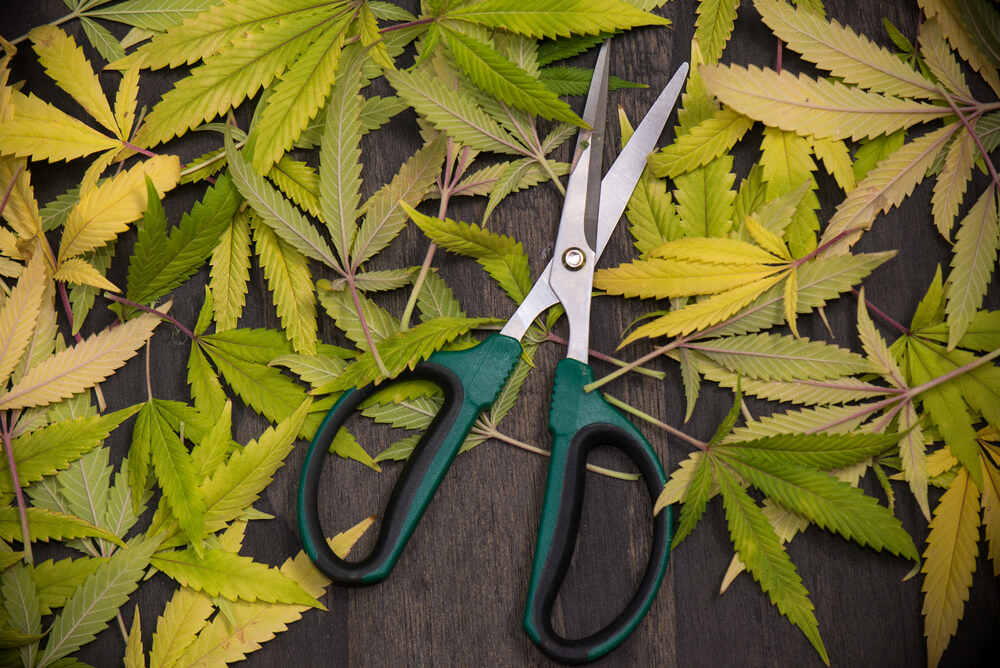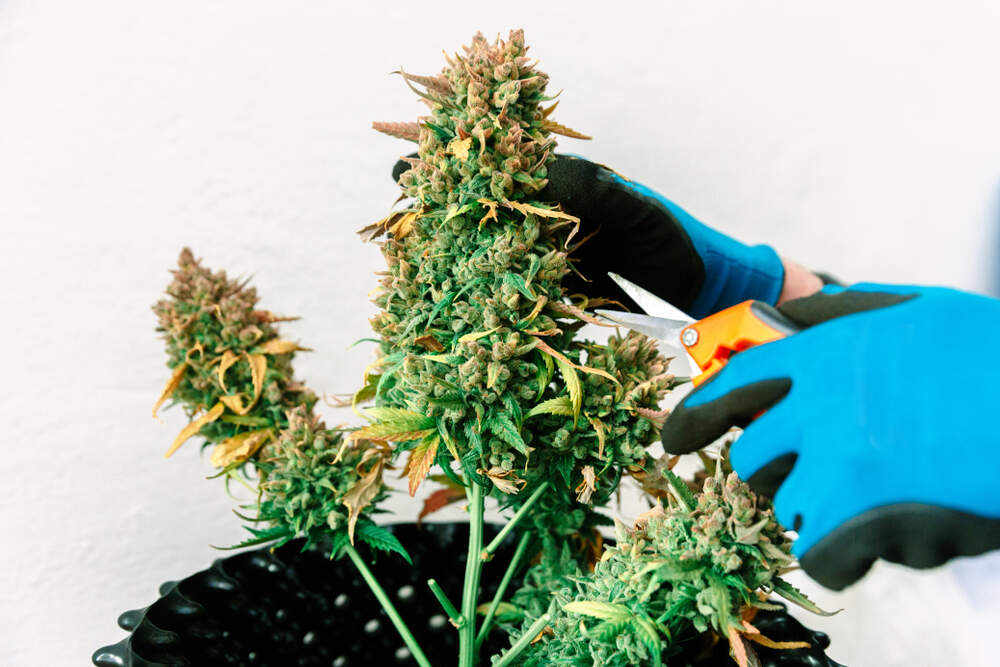
Can you defoliate autoflowers?
Yes, you can definitely remove some of the fan leaves from your autoflowering weed strains, but there’s more to it than just simply plucking them off.
Defoliating (or pruning) weed plants is a bit of a controversial issue, and the debate only gets more heated when the question focuses on autoflowering strains.
Sure, many growers do it, but a quick Google search (especially the forums) shows more than a handful of comments along the lines of “Defoliating leads to lower yields”, “It stunts growth”, “Do not remove leaves from autoflowers!”, or even prophecies of doom like “DO NOT DEFOLIATE, IT WILL KILL YOUR CHANCES AT A DECENT HARVEST”…
All a little dramatic, if you ask us.
By the end of this article, you will know the truth about autoflower strain pruning, and you’ll be ready to give it a go yourself.
Why do you defoliate autoflowers?
Although cutting parts of your plants may seem like the opposite of a good idea, experienced weed growers defoliate their autoflowering cannabis plants regularly and for more than one reason.
Well, kind of. We all grow with one goal in mind – huge harvests! Pruning (when done correctly) does just that.
- It allows for better light penetration – Removing some of the larger fan leaves from your autoflowering plants will let more of that precious light peak through the canopy and reach the lower bud sites. More light penetration = bigger, better buds.
- It increases airflow – It’s not just light penetration that is improved with defoliation, your plant’s air circulation will be increased too. Increased airflow means a lower chance of pests or diseases taking hold and causing damage (or worse), and the more air exchange, the better your plants will be able to ‘breathe’.
- It encourages growth in the right places – By removing the leaves covering your plant’s bud sites, you’re also showing it where to focus its energy and growth. The more energy spent on your buds, the bigger and more potent they will be.
Is it safe to defoliate autoflowers?

Yes, but that comes with a few caveats.
Defoliation comes with a slight level of risk, but again, as long as you prune your plants at the right time and with the right technique, the chances of anything going wrong are pretty small.
In fact, if you do it right your plant will thank you for it!
The most important thing to remember when defoliating your autoflowering plants is to be gentle – these plants can be quite sensitive, so take your time and don’t rush the process.
When should you defoliate autoflowers?
Now, this is where a lot of the heated debate comes from, as there isn’t a one-size-fits-all answer to this question.
The general rule of thumb is to only defoliate your autoflowering plants during their vegetative growth, but rules are made to be broken, right?
If you are new to growing, or even an everyday Dr. Greenthumb but new to autos, then yes, you should probably only prune your plants during the veg stage. Autos are resilient, robust little buggers, but the fact that they only have a short growth cycle means that they can’t always bounce back from mistakes as easily as your regular photoperiod plants.
An exception to this rule for novice growers is if you notice any significant leaf damage or disease on your plants. In this case, it may be necessary to remove the affected leaves, regardless of the plant’s stage.
But what if you have grown autoflowering weed strains in the past and feel like you have a good understanding of how a specific strain grows?
Then, by all means, do as you like. We are not here to play babysitter, just to offer advice. Keep the pruning during flower production to a minimum, though, as your plant will already be pushing its limits to grow and mature in such a short timeframe.
Step by step guide on how to defoliate autoflowers
First up, grab some tools.
Old hands at growing weed sometimes just pinch the leaves off, but this comes with risks, so we recommend you grab a nice sharp set of trimming scissors, give them a soak in some rubbing alcohol, and wash your hands before getting started.
Every time you make a cut, you open up the plant to possible infections, so hygiene is essential. grab
- Choose your target – Identify the leaves you want to remove. Never take more than about 25% of the fan leaves off at one time. Doing so will cause too much stress on the plant and could lead to stunted growth or even death.
- Prepare your plants – The best time to defoliate your autoflowering plants is in the morning, just as they’re waking up. This gives them plenty of time to recover before their next lights-out period.
- Remove the leaves – Using a gentle, snipping motion, remove the targeted leaves from the plant. Start with the larger fan leaves, and its usually best to start at the bottom of the plant and work your way up.
- Clean up – Once you’ve made the cut, clean up! You don’t want rotting plant material lying around your grow room, so discard the leaves in a compost bin or trash bag.
- Water – As with any stress-inducing activity, it’s always best to give the girls a good watering after defoliation. This will help them recover quicker and ease stress on the plant.
- Monitor – Keep a close eye on the pruned plants over the next few days to make sure they’re recovering well. If you see any signs of stress, such as yellowing or wilting leaves, decrease the amount of defoliation next time.
Defoliation vs topping
Defoliating usually refers to removing fan leaves, but topping can also be classed as a type of defoliation.
Topping is a high-stress plant training technique that involves removing the tips of your plant’s main stem or branches, forcing it to grow two new shoots in its place. Although we top pretty much every photoperiod strain we grow, we never top autos. It just causes too much stress, and we don’t want to risk stunting their growth or affecting their yield.
Alternatively if you want a less risky technique then using low stress training alongside light defoliation.
Defoliation vs lollipopping
Defoliation and lollipopping are two pruning technique that are used on cannabis.
Defoliation involves removing leaves from a plant to encourage new growth, improve air circulation, or increase light penetration with goal being to promote healthier growth and to direct the plant’s energy to specific areas.
Lollipopping, on the other hand, refers to removing the lower branches and leaves of a plant that receive less light, typically to force the plant to focus its energy on the top part of the canopy where the buds grow.
What is the schwazzing technique?
If you thought regular defoliation was controversial, wait until we tell you about schwazzing.
Schwazzing is a high-stress defoliation technique that involves removing almost all of the plant’s fan leaves before it even starts to flower. This is a very risky technique and should only be attempted by experienced growers.
NEVER SCHWAZZ AUTOS, SIMPLE.
Well, (maybe) never is a little too strong. Only shcwazz the autos you are willing to experiment with, and have a backup grow on the go just in case.
How many fan leaves should you remove?
We don’t like to take more than 25% of the fans leaves off at any one time, and then we let the plant fully recover before taking more. Some growers like to take just a few at a time, and do so more regularly, but this really depends on the strain and your personal preference.
Is pruning autoflowers the same as defoliation?
Yep, both pruning and defoliation usually refer to the same practice when it comes to weed plants. They can both also mean removing any part of the plant, fan leaves or not, but in weed circles, they usually mean removing the fan leaves to increase light and airflow.
Can you defoliate during flowering?
You can, but it is high risk.
Weed plants go through two distinct growth stages – vegetative and flowering. During the vegetative stage, plants focus on growing and developing leaves, stems, and branches – the structure of the plant.
The flowering period follows, and is, you guessed it, all about the production of buds (flowering). Every ounce of their energy goes into growing those delicious, dank, juicy buds. But when you prune or defoliate, you’re essentially stressing the plant, forcing it to expend some of that precious energy on healing instead of bud production.
With that said, if you have one or two leaves blocking critical bud sites, then it’s okay to remove them gently. Or you could try to just ‘tuck’ them out of the way, so to speak.
The wrap-up
Defoliating weed plants, and especially autoflowering cultivars, comes with at least a sprinkling of risk. But as they say – No pain, no gain. As long as you are careful, and follow the simple guidelines set out in this write-up, you and your favourite plants should be just fine.
Growing weed, and especially autos, is supposed to be fun! Autos have such a quick seed to harvest timing, which makes them the perfect subjects to run a few experiments on.
So, what are you waiting for? Grab a fistful of the best autoflowering genetics from right here and get planting!
